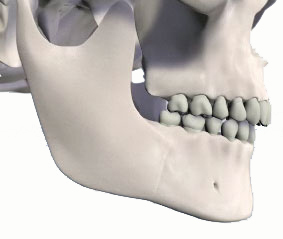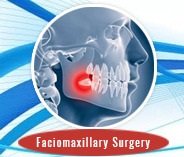Orthognathic surgery is a maxillofacial jaw surgery to correct conditions of the jaw and face related to structure, growth, sleep apnea, TMJ disorders, malocclusion problems owing to skeletal disharmonies, or other orthodontic problems that cannot be easily treated with braces alone. It is also used in treatment of congenital conditions like cleft palate. Bones can be cut and re-aligned, then held in place with either screws or plates and screws.
Candidates for Orthognathic jaw surgery
Patients from ages 18 to 45 years of age are the best candidates for corrective jaw surgery. Orthognathic surgery is performed after the age of 18 years when the jaws normally stop growing. Orthognathic surgery is rarely used on children under 18 years of age. Their treatment is limited to orthodontics and growth modification of the jaws; however, if orthodontic treatment is not effective, the patient and parents must give their consent before setup for orthognathic surgery is initiated. The overall medical state and dentition, rather than the age, is of primary concern when considering orthognathic surgery for the elderly. It’s possible to operate on a senior patient; however, due to their possible weaker physical condition and worse dental and periodontal status, the orthodontic setup may be complicated, if possible at all.
 Orthognathic Surgery Procedure
Orthognathic Surgery Procedure
Orthognathic surgery is performed either by an Oral and Maxillofacial Surgeon in collaboration with an orthodontist. It often includes braces before and after surgery and retainers after the final removal of braces. Orthognathic surgery is often needed after reconstruction of cleft palate or other major craniofacial anomalies. Careful coordination between the surgeon and orthodontist is essential to ensure that the teeth will fit correctly after the surgery.
The surgery might involve one jaw or the two jaws during the same procedure. The modification is done by making cuts in the bones of the mandible and / or maxilla and repositioning the cut pieces in the desired alignment. Usually surgery is performed under general anaesthesia. The surgery often does not involve cutting the skin, and instead, the surgeon is often able to go through the inside of the mouth.
Cutting the bone is called osteotomy and in case of performing the surgery on the two jaws at the same time it is called a bi-maxillary osteotomy (upper and lower jaws bone cutting) or maxillomandibular advancement. The bone cutting is traditionally done using special electrical saws and burs, and manual chisels. The maxilla can be adjusted using a “Lefort I” level osteotomy (most common). Sometimes the midface can be mobilized as well by using a Lefort II, or Lefort III osteotomy. These techniques are utilized extensively for children suffering from certain craniofacial abnormalities such as Crouzon syndrome.
The jaws will be wired together (inter-maxillary fixation) using stainless steel wires during the surgery to insure the correct re-positioning of the bones. This in most cases is released before the patient wakes up. Some surgeons prefer to wire the jaws shut.
Complications of Orthognathic Surgery
Complications seen in any major surgery under general anaesthesia maybe seen in orthognathic surgery
- Swelling, pain, nausea, vomiting, bleeding, infection, chest infections, etc are some of the potential risks of any major surgery under general anaesthesia. Other complications specific to orthognathic surgery are
- Loss of sensation resulting in numbness or tingling sensation of the chin, cheek, nose or tongue may occur after surgery. Sensation returns to the affected areas as the nerve fibres regenerate and mend themselves, after a few months of surgery. Rarely some individuals may experience permanent altered sensation.
- Sinus complications such as sinusitis may occur after surgeries of the maxilla. This may not require any further treatment as it usually corrects itself after a period of time.
- Nonvitality of teeth near the osteotomy site is seen rarely. This may require root canal treatment of the involved tooth at a later date.
- Relapse or unpredicted shifting of the new jaw position occurs uncommonly. If it does then further surgical intervention would be necessary.
- Periodontal infections around the teeth near the osteotomy site may cause mobility of the concerned teeth. This may be corrected by periodontal flap surgery and bone graft.
- Necrosis of bone is seen very rarely. This could be due to reduced blood supply to the area and will require surgical removal of the infected bone.
Cost of Orthognathic Surgery or Corrective jaw surgery in India
Dental care has become a specialty in India with the latest innovations in medical electronics with unmatched expertise and dental surgeons. Medical Institutes are well equipped to handle all phases of heart diseases from the elementary to the latest clinical procedures. The cost of these treatments and surgeries is one fourth of what it would cost in the western and the European Countries. India is fast becoming the world’s first choice destination for healthcare services – especially dental surgery. With rapidly expanding infrastructure, clinical expertise and international standard implementation, it is servicing the healthcare needs, at reasonable costs, of international patients from around the world. Jaw or orthognathic surgery’s cost in India is among the most affordable in the world. Cosmozone is no different!















